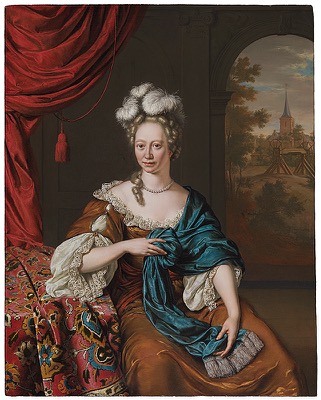 Portrait of a lady in an interior, by Willem van Mieris (Leiden, 1662-1747) and dating to 1694. The painting is in the Leiden Collection, New York.First and foremost, may 2024 be a peaceful year! After opening on Monday 15th, the first week back at the TRC has been very stimulating. A quick survey of some of the events and activities will give you a better idea of what can happen at the TRC!
Portrait of a lady in an interior, by Willem van Mieris (Leiden, 1662-1747) and dating to 1694. The painting is in the Leiden Collection, New York.First and foremost, may 2024 be a peaceful year! After opening on Monday 15th, the first week back at the TRC has been very stimulating. A quick survey of some of the events and activities will give you a better idea of what can happen at the TRC!
We recently announced the Turkish henna party being held by the Leiden-based Stichting Güney at the TRC on Sunday, the 28th January. Its going to be a busy event as already over 40 people have registered to attend!
On a totally different subject: The Leiden Collection, New York, contacted us about the identification of lace in 17th century Dutch paintings, in particular the portrait of a lady in an interior by the Leiden painter, Willem van Mieris (1662-1747) and dating to 1694.
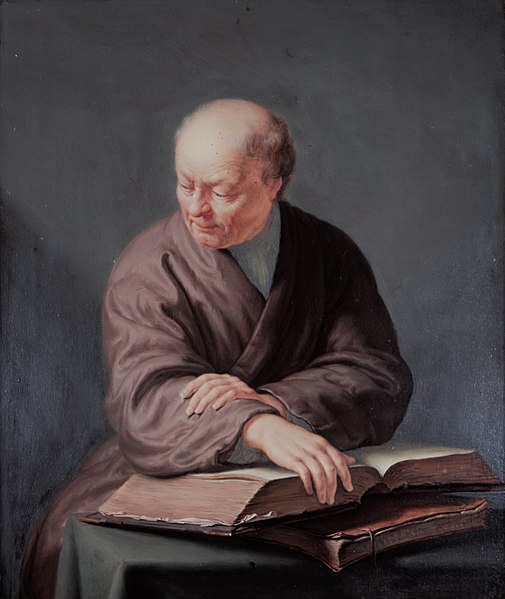 The Leiden painter, Willem van Mieris, 1662-1747, portrayed by his son, Frans van Mieris. Private collection.One of my colleagues, bobbin lace teacher, Gon Homburg, was able to identify the lace as that of Venetian Gros Point, also known as Venetian Raised Needle Lace (or possibly an imitation), a form of needle lace very popular among the 17th and 18th century elite in western Europe. It’s really interesting being able to add more details to paintings, about textiles and accessories, and seeing lace being used both as an object (decoration of a sleeve cuff) and as a symbol (status and wealth). It was also nice to emphasise the Leiden connection.
The Leiden painter, Willem van Mieris, 1662-1747, portrayed by his son, Frans van Mieris. Private collection.One of my colleagues, bobbin lace teacher, Gon Homburg, was able to identify the lace as that of Venetian Gros Point, also known as Venetian Raised Needle Lace (or possibly an imitation), a form of needle lace very popular among the 17th and 18th century elite in western Europe. It’s really interesting being able to add more details to paintings, about textiles and accessories, and seeing lace being used both as an object (decoration of a sleeve cuff) and as a symbol (status and wealth). It was also nice to emphasise the Leiden connection.
Speaking of lace, we have a new intern at the TRC. She is Olivia Buchan, from Scotland, but doing an MA in Russian and Central Asian studies at Leiden University She has started to learn bobbin lace making at the TRC. Her lace teacher, Gon Homburg, thinks she is a natural bobbin lace maker (something that is not that common. Swinging the bobbins is not easy, and I speak from personal experience).
We agreed this week that Olivia is going to help with the TRC’s lace collection and learn about lace identification and the archiving of lace. We currently have about 1200 samples of hand and machine made lace, so there is plenty to do. And continuing the lace theme: The next set of bobbin lace classes at the TRC starts on the 31st January and will focus on the theme of figurative bobbin lace making.
Some Palestinian items from the TRC Collection were picked up on Thursday with the intention that they will go on display in an embroidery exhibition called D(R)AAD, which will be held at the Verwey Museum, Haarlem. The exhibition is about embroidery as a form of protest and healing and includes the work of various modern, textile artists. The exhibition will open on the 27th January and can be visited until the 21st April 2024.
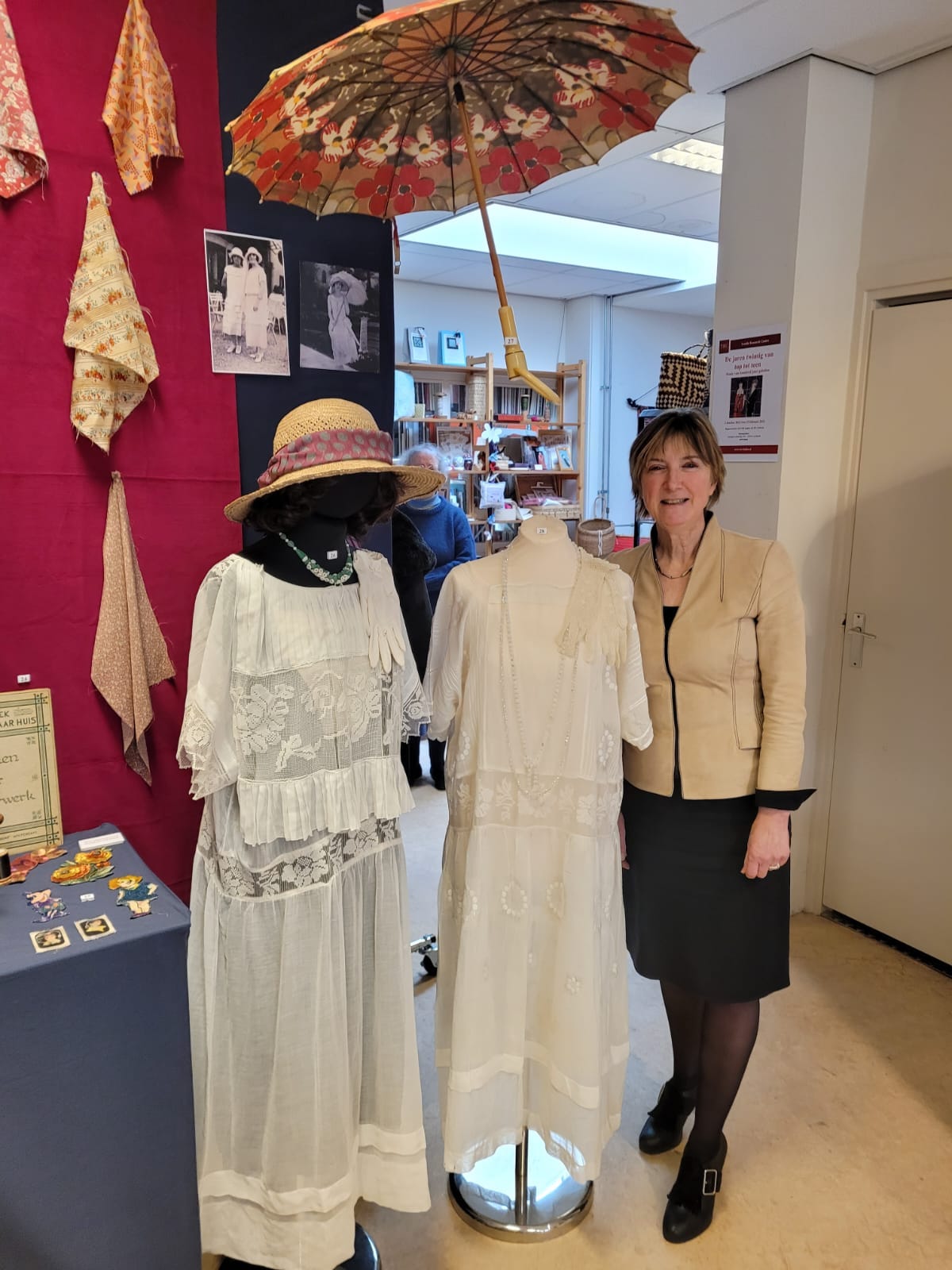 Prof. Annetje Ottow, Chair of the Leiden University Board, on a recent visit to the TRC with garments of her great-aunt from the 1920s Dutch East Indies.Then various groups came to the TRC this week, including Prof. Annetje Ottow, who is Chair of Leiden University Board. In 2022 her family donated a wonderful collection of garments and accessories, which belonged to a great aunt, to the TRC. The objects date to the early 1920s and have strong Dutch and Dutch East Indian connections.
Prof. Annetje Ottow, Chair of the Leiden University Board, on a recent visit to the TRC with garments of her great-aunt from the 1920s Dutch East Indies.Then various groups came to the TRC this week, including Prof. Annetje Ottow, who is Chair of Leiden University Board. In 2022 her family donated a wonderful collection of garments and accessories, which belonged to a great aunt, to the TRC. The objects date to the early 1920s and have strong Dutch and Dutch East Indian connections.
Some of these garments are on display in the TRC’s latest exhibition about 1920s fashion (last week an online version was added to the TRC's extensive list of online exhibitions) and Prof. Ottow was curious to see them again. Augusta de Gunzbourg, who curated the exhibition, did a guided tour and we also discussed the work of the TRC and its connections with Leiden University.
We also mentioned our next exhibition, which will be about Chinese dress (partially based on the Quirina Vreeburg donation to the TRC of Chinese textiles, garments and accessories), and which will also include some Ottow family items, notably some Chinese garments worn in the Dutch East Indies. It is with great pleasure that we can now announce that Prof. Ottow has very kindly agreed to open the exhibition in March! More details in due course.
Then we had a special visit from the Department of Industrial Design, Eindhoven University of Technology. Dr. Kristina Andersen and Dr. Bruna Goveia da Rocha came to Leiden to talk about the setting up of a textile archive in Eindhoven, in order to help designers and students at the university. During the discussions it was noted that many modern textiles are becoming flatter, as physical weaving skills (especially of textured forms) are not passed on to the same extent as before – they are regarded as too difficult by some!
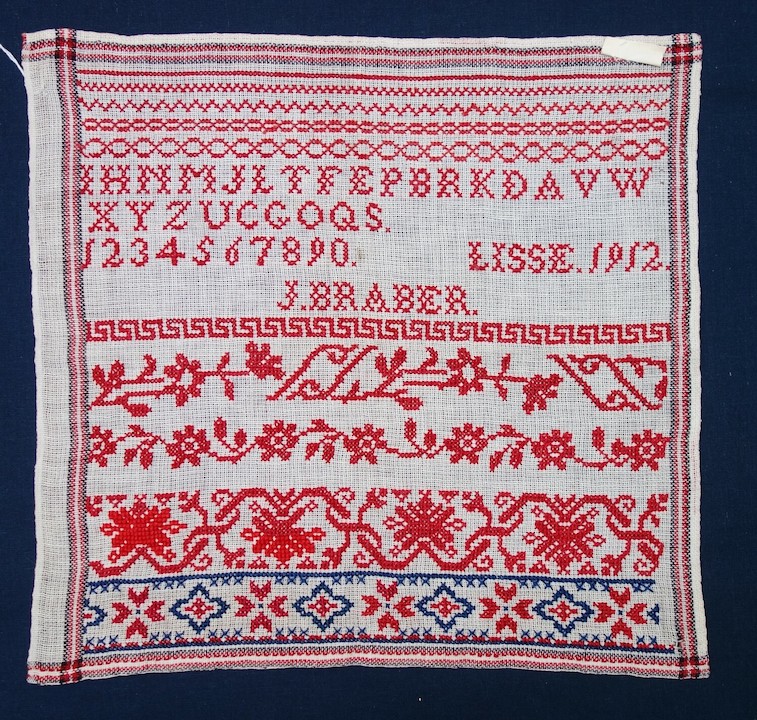 School sampler with lines of repeating geometric and floral motifs, as well as an alphabet, a set of numbers and the text: "LISSE 1912 J. BRABER" (TRC 2023.2906).Furthermore, the use of computer screens to design particular weaves and printed textiles means that many designers are no longer used to handling textiles. So textile archives, such as the TRC’s Reference Collection, are needed to provide more data and inspiration, and people are coming to the TRC to see our collections and learn how to set up their own collection.
School sampler with lines of repeating geometric and floral motifs, as well as an alphabet, a set of numbers and the text: "LISSE 1912 J. BRABER" (TRC 2023.2906).Furthermore, the use of computer screens to design particular weaves and printed textiles means that many designers are no longer used to handling textiles. So textile archives, such as the TRC’s Reference Collection, are needed to provide more data and inspiration, and people are coming to the TRC to see our collections and learn how to set up their own collection.
The idea of the TRC as an international hub for textile knowledge in all the depth and width of this huge, thematic subject is basically no longer a pipe-dream, as far as we are concerned, it is the TRC’s reality! More meetings will be held with colleagues from Eindhoven in due course to discuss further ways of working together. One of the more concrete plans is to set up a joint exhibition about samplers and their design histories and uses!
And yesterday, Friday, there was a meeting with senior members of various institutes based in Leiden about the future of the TRC. The groups came from Leiden Council, museums including Lakenhal and the Wereldmuseum, as well as Leiden University. The meeting was held as part of the writing of a feasibility plan that is currently being researched by Peter Inklaar and Carin Reinders, of the non-profit consultancy company, Charistar. We hope the plans will be presented in March.
I must admit it was encouraging to hear, also at the meeting yesterday, how other people perceive the role of the TRC on a local, national and international level for the study of textiles and dress; a field that has grown especially over the last few years and the TRC is becoming more and more a facility that is of use to so many different individuals and groups. We’re an international textile hub, as we keep muttering, loudly! Only last week a PhD student in America contacted us about Moroccan embroidery and by co-incidence a few days ago a collector and admirer of embroidery wrote to me on a similar theme and we have put them into contact with each other.
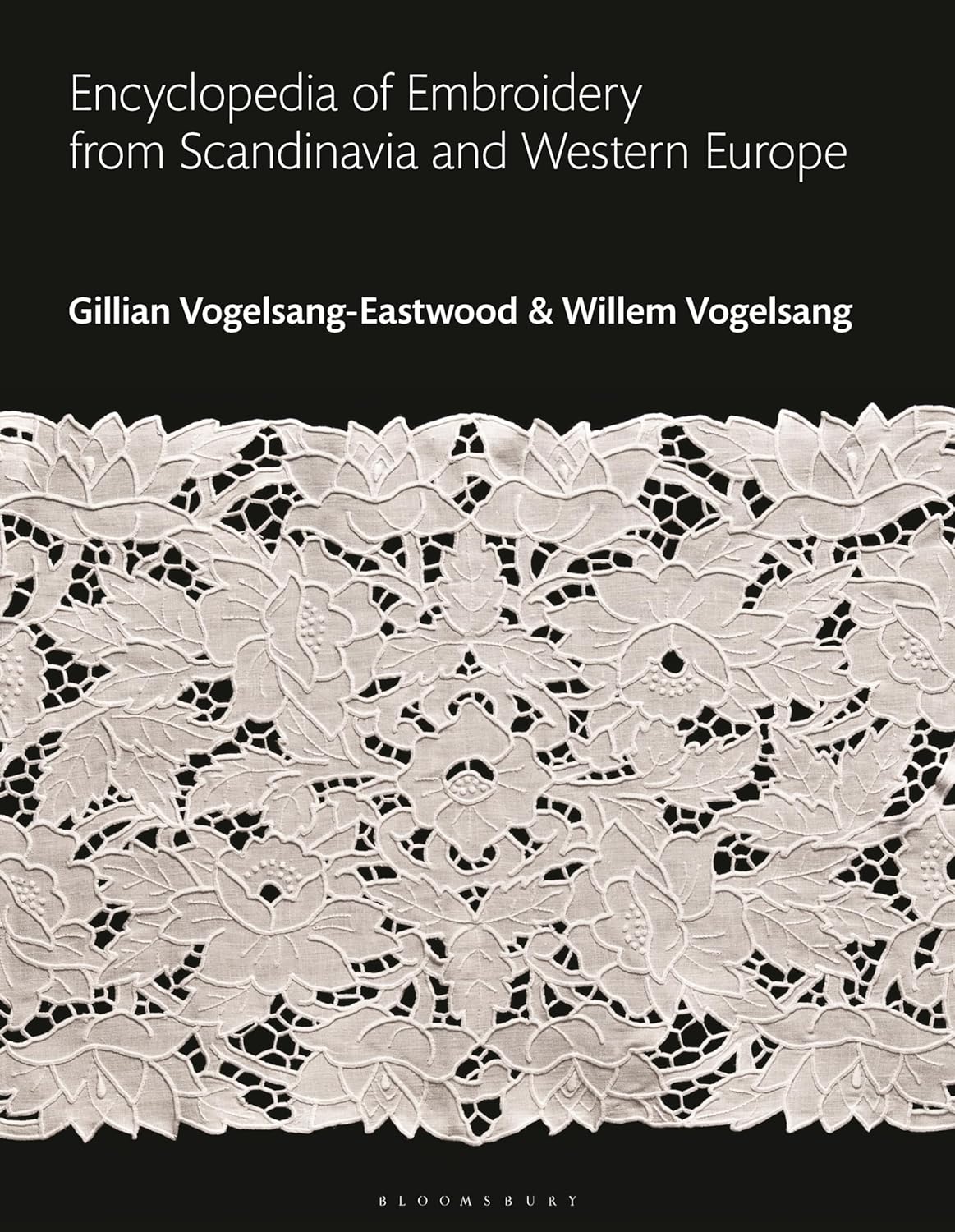 And what is happening next week? Well, the Mayor of Leiden, Peter van der Velden, and the Wethouder Cultuur, Yvonne van Delft (a long-time supporter of the TRC) are popping in on Monday to discuss textiles, the TRC and Leiden.
And what is happening next week? Well, the Mayor of Leiden, Peter van der Velden, and the Wethouder Cultuur, Yvonne van Delft (a long-time supporter of the TRC) are popping in on Monday to discuss textiles, the TRC and Leiden.
On Wednesday there is a workshop on Needlebinding, and on Friday Willem and I hope to drive to Nice in southern France for a few days to meet some old friends who used to live and work in Kabul, Afghanistan, and who are now donating some of their textiles and other objects from that fascinating, but sad country to the TRC.
And last but not least, we just noticed today that Bloomsbury in London has announced via Amazon the upcoming publication of part IV of the World Encyclopedia of Embroidery (covering Western Europe and Scandinavia), published under the aegis of the TRC, due to come out in November this year. We are eagerly awaiting the proofs, promised within a few weeks, all 688 pages of them.
Gillian Vogelsang-Eastwood, 20 January 2024










